Critical Analysis of Leadership for Quality & Safety in Healthcare
VerifiedAdded on 2023/06/03
|14
|2705
|321
Report
AI Summary
This report critically analyzes the role of leadership in ensuring quality and safety within healthcare, focusing on the impact of human factors on work performance. It explores key concepts such as organizational culture, workgroup dynamics, the working environment, and individual factors, examining their relationship to healthcare quality and patient safety. The analysis delves into issues like communication failures, team coordination, workplace hazards, and decision-making processes, highlighting how these elements influence overall healthcare outcomes. The report concludes by emphasizing the importance of addressing human factors and promoting effective leadership strategies to enhance patient safety and improve the quality of healthcare services. Desklib provides access to this and many other solved assignments to help students in their academic journey.
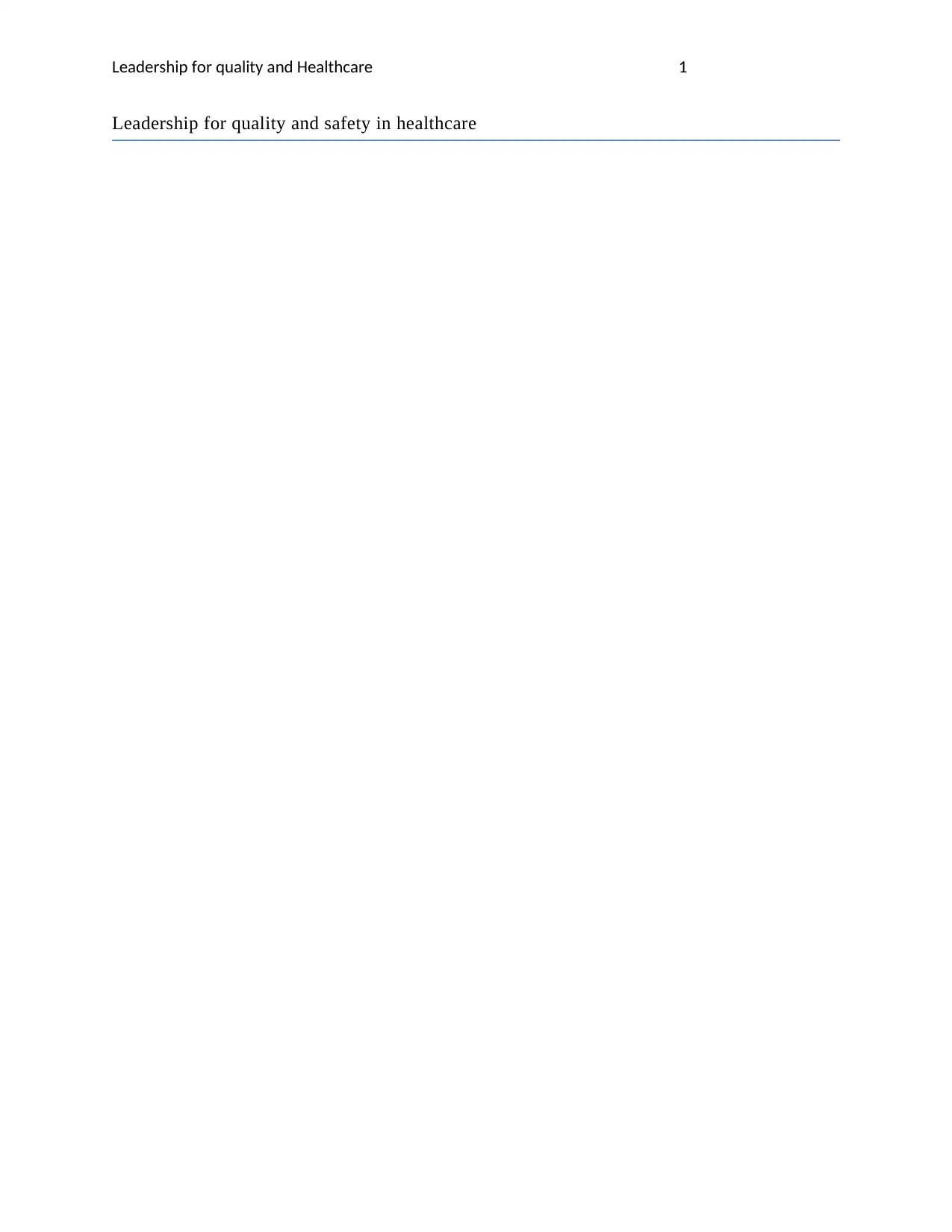
Leadership for quality and Healthcare 1
Leadership for quality and safety in healthcare
Leadership for quality and safety in healthcare
Paraphrase This Document
Need a fresh take? Get an instant paraphrase of this document with our AI Paraphraser

Leadership for quality and Healthcare 2
Contents
Introduction.................................................................................................................................................3
Major concepts and key issues....................................................................................................................5
Their relationship to quality and safety in healthcare................................................................................10
References.................................................................................................................................................14
Contents
Introduction.................................................................................................................................................3
Major concepts and key issues....................................................................................................................5
Their relationship to quality and safety in healthcare................................................................................10
References.................................................................................................................................................14

Leadership for quality and Healthcare 3
Introduction
Patient safety is considered as the global challenge that needs knowledge and capabilities in a
number of areas such as human factors and systems engineering (Spence Laschinger, Leiter, Day
&Gilin, 2009). Human factors are those that refer to organizational, environmental and various
characteristics of human and individual, which persuade behavior at job in an approach which
can influence health and safety. The human factors have a significant role in work performance.
It is required for the business to ensure health and safety in order to get high productivity and
quality. The combination of good technology is required for the best work systems which would
be helpful in attaining the goals. The best work systems are based on having a talented workforce
with effectively designed jobs that are systematic to the abilities of the individual.
The aim of the report
To explore the human factors that impact on work performance.
To identify the bonding between these and quality and safety in health care provisions.
To analyze the concept as well as key issues connected to the human factors and
performance of place of work.
Thesis statement
“Human factors systems approach to healthcare quality and patient safety”.
This report will include the critical study and discussion of all main concepts and major issues
regarding human factors and workplace performance. Further, their relationship to quality and
safety in healthcare will be elaborated in-depth manner. At last, the conclusion will be drawn in
order to get summarized about all contents of this report.
Introduction
Patient safety is considered as the global challenge that needs knowledge and capabilities in a
number of areas such as human factors and systems engineering (Spence Laschinger, Leiter, Day
&Gilin, 2009). Human factors are those that refer to organizational, environmental and various
characteristics of human and individual, which persuade behavior at job in an approach which
can influence health and safety. The human factors have a significant role in work performance.
It is required for the business to ensure health and safety in order to get high productivity and
quality. The combination of good technology is required for the best work systems which would
be helpful in attaining the goals. The best work systems are based on having a talented workforce
with effectively designed jobs that are systematic to the abilities of the individual.
The aim of the report
To explore the human factors that impact on work performance.
To identify the bonding between these and quality and safety in health care provisions.
To analyze the concept as well as key issues connected to the human factors and
performance of place of work.
Thesis statement
“Human factors systems approach to healthcare quality and patient safety”.
This report will include the critical study and discussion of all main concepts and major issues
regarding human factors and workplace performance. Further, their relationship to quality and
safety in healthcare will be elaborated in-depth manner. At last, the conclusion will be drawn in
order to get summarized about all contents of this report.
⊘ This is a preview!⊘
Do you want full access?
Subscribe today to unlock all pages.

Trusted by 1+ million students worldwide
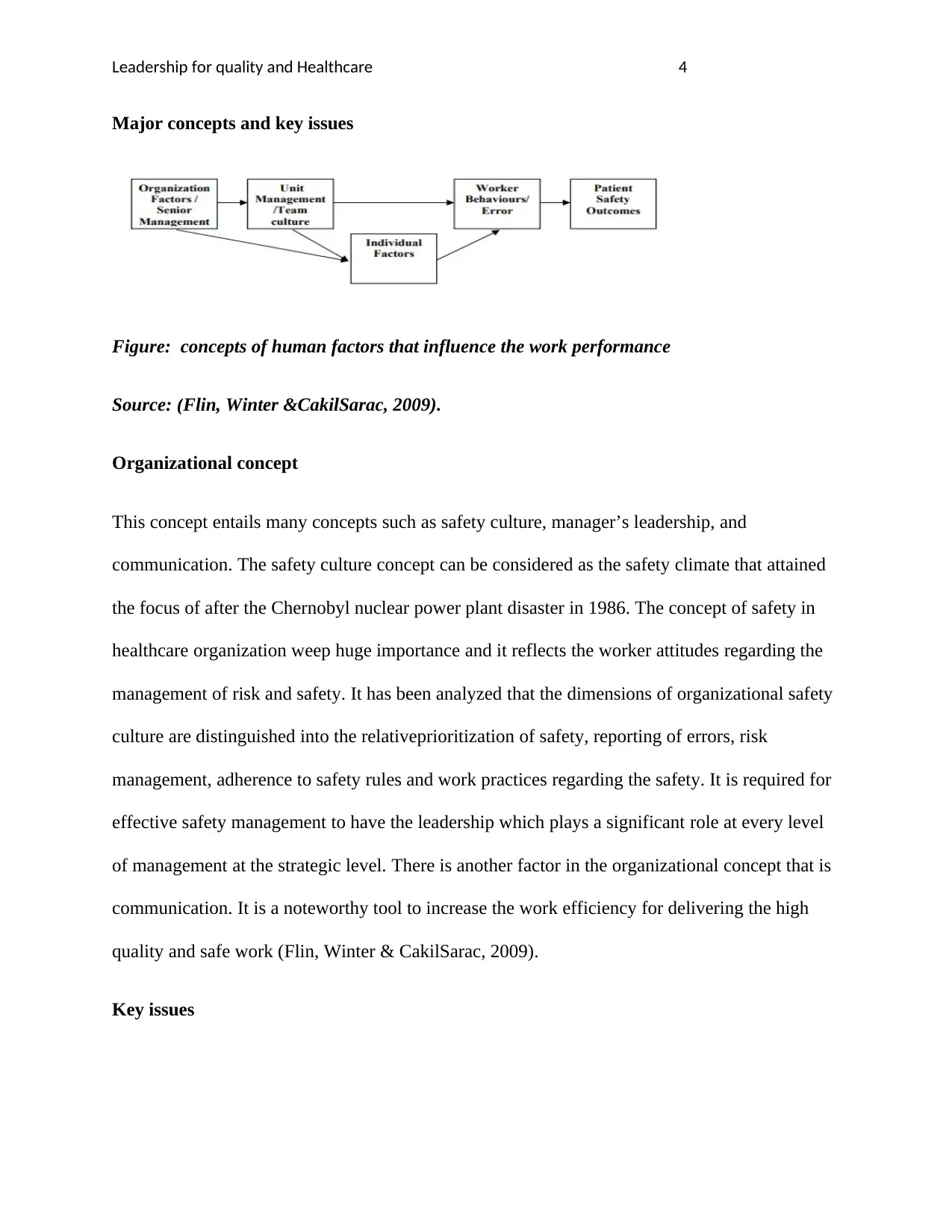
Leadership for quality and Healthcare 4
Major concepts and key issues
Figure: concepts of human factors that influence the work performance
Source: (Flin, Winter &CakilSarac, 2009).
Organizational concept
This concept entails many concepts such as safety culture, manager’s leadership, and
communication. The safety culture concept can be considered as the safety climate that attained
the focus of after the Chernobyl nuclear power plant disaster in 1986. The concept of safety in
healthcare organization weep huge importance and it reflects the worker attitudes regarding the
management of risk and safety. It has been analyzed that the dimensions of organizational safety
culture are distinguished into the relativeprioritization of safety, reporting of errors, risk
management, adherence to safety rules and work practices regarding the safety. It is required for
effective safety management to have the leadership which plays a significant role at every level
of management at the strategic level. There is another factor in the organizational concept that is
communication. It is a noteworthy tool to increase the work efficiency for delivering the high
quality and safe work (Flin, Winter & CakilSarac, 2009).
Key issues
Major concepts and key issues
Figure: concepts of human factors that influence the work performance
Source: (Flin, Winter &CakilSarac, 2009).
Organizational concept
This concept entails many concepts such as safety culture, manager’s leadership, and
communication. The safety culture concept can be considered as the safety climate that attained
the focus of after the Chernobyl nuclear power plant disaster in 1986. The concept of safety in
healthcare organization weep huge importance and it reflects the worker attitudes regarding the
management of risk and safety. It has been analyzed that the dimensions of organizational safety
culture are distinguished into the relativeprioritization of safety, reporting of errors, risk
management, adherence to safety rules and work practices regarding the safety. It is required for
effective safety management to have the leadership which plays a significant role at every level
of management at the strategic level. There is another factor in the organizational concept that is
communication. It is a noteworthy tool to increase the work efficiency for delivering the high
quality and safe work (Flin, Winter & CakilSarac, 2009).
Key issues
Paraphrase This Document
Need a fresh take? Get an instant paraphrase of this document with our AI Paraphraser

Leadership for quality and Healthcare 5
A human factors analysis is elaborate that most errors could be featured in poor communication
between nurses and physicians. It has been found that there are many factors that influence the
work performance of the healthand care system such as lack of safety culture, improper
communication and lack of training. These key issues can become the major reason for patient
death
Figure: The frequency of different communication issues
Source: (Thomas & MacDonald, 2016).
The above mentioned image shows that the lack of communication can become the major reason
for improper services of health and safety culture. Along with that, there are various categories
of communication failures such as organization system failures, transmission failures and
reception failure. These concepts are being the major reason for human factors that affect the
work Performance of the employee (Mike, 2010).
Workgroup concept
A human factors analysis is elaborate that most errors could be featured in poor communication
between nurses and physicians. It has been found that there are many factors that influence the
work performance of the healthand care system such as lack of safety culture, improper
communication and lack of training. These key issues can become the major reason for patient
death
Figure: The frequency of different communication issues
Source: (Thomas & MacDonald, 2016).
The above mentioned image shows that the lack of communication can become the major reason
for improper services of health and safety culture. Along with that, there are various categories
of communication failures such as organization system failures, transmission failures and
reception failure. These concepts are being the major reason for human factors that affect the
work Performance of the employee (Mike, 2010).
Workgroup concept
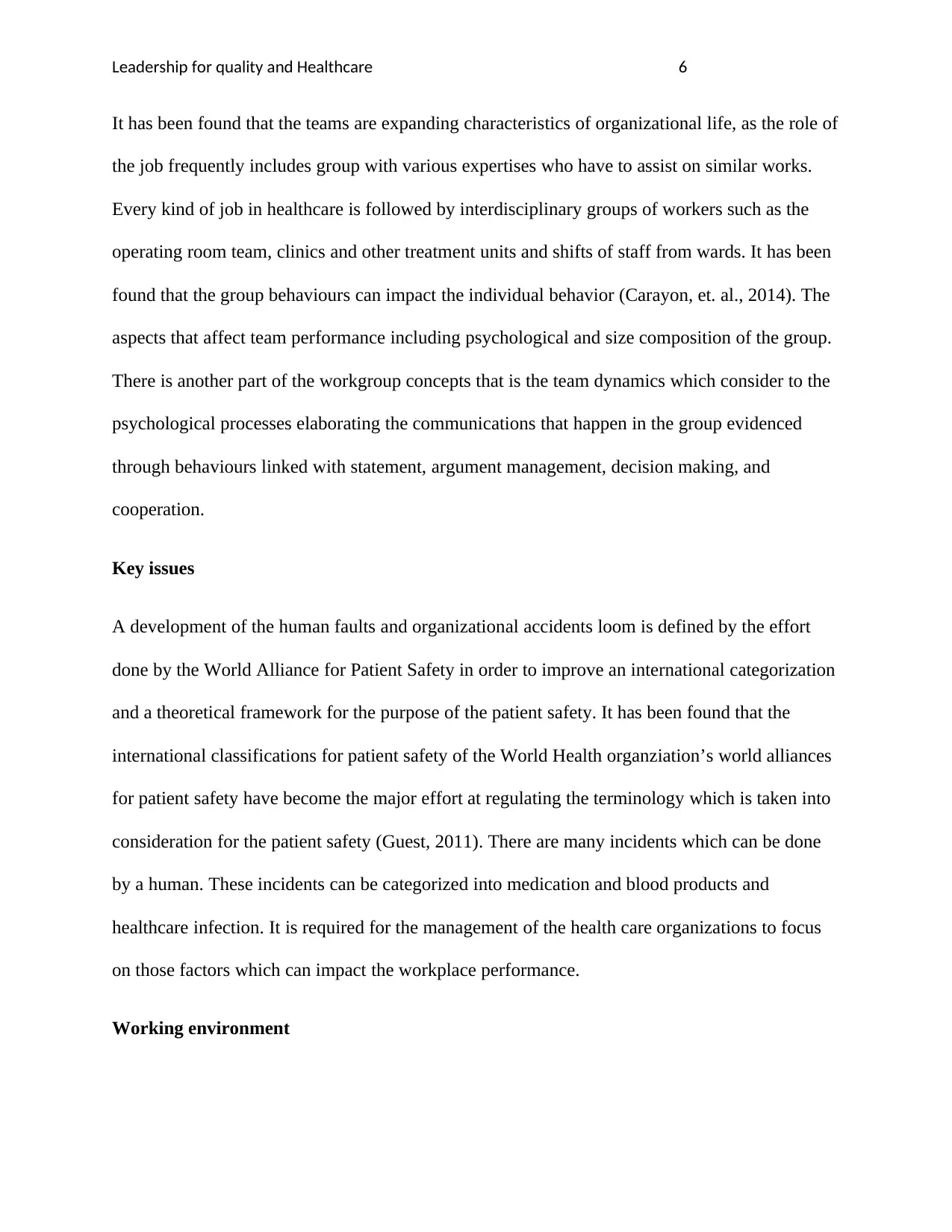
Leadership for quality and Healthcare 6
It has been found that the teams are expanding characteristics of organizational life, as the role of
the job frequently includes group with various expertises who have to assist on similar works.
Every kind of job in healthcare is followed by interdisciplinary groups of workers such as the
operating room team, clinics and other treatment units and shifts of staff from wards. It has been
found that the group behaviours can impact the individual behavior (Carayon, et. al., 2014). The
aspects that affect team performance including psychological and size composition of the group.
There is another part of the workgroup concepts that is the team dynamics which consider to the
psychological processes elaborating the communications that happen in the group evidenced
through behaviours linked with statement, argument management, decision making, and
cooperation.
Key issues
A development of the human faults and organizational accidents loom is defined by the effort
done by the World Alliance for Patient Safety in order to improve an international categorization
and a theoretical framework for the purpose of the patient safety. It has been found that the
international classifications for patient safety of the World Health organziation’s world alliances
for patient safety have become the major effort at regulating the terminology which is taken into
consideration for the patient safety (Guest, 2011). There are many incidents which can be done
by a human. These incidents can be categorized into medication and blood products and
healthcare infection. It is required for the management of the health care organizations to focus
on those factors which can impact the workplace performance.
Working environment
It has been found that the teams are expanding characteristics of organizational life, as the role of
the job frequently includes group with various expertises who have to assist on similar works.
Every kind of job in healthcare is followed by interdisciplinary groups of workers such as the
operating room team, clinics and other treatment units and shifts of staff from wards. It has been
found that the group behaviours can impact the individual behavior (Carayon, et. al., 2014). The
aspects that affect team performance including psychological and size composition of the group.
There is another part of the workgroup concepts that is the team dynamics which consider to the
psychological processes elaborating the communications that happen in the group evidenced
through behaviours linked with statement, argument management, decision making, and
cooperation.
Key issues
A development of the human faults and organizational accidents loom is defined by the effort
done by the World Alliance for Patient Safety in order to improve an international categorization
and a theoretical framework for the purpose of the patient safety. It has been found that the
international classifications for patient safety of the World Health organziation’s world alliances
for patient safety have become the major effort at regulating the terminology which is taken into
consideration for the patient safety (Guest, 2011). There are many incidents which can be done
by a human. These incidents can be categorized into medication and blood products and
healthcare infection. It is required for the management of the health care organizations to focus
on those factors which can impact the workplace performance.
Working environment
⊘ This is a preview!⊘
Do you want full access?
Subscribe today to unlock all pages.

Trusted by 1+ million students worldwide

Leadership for quality and Healthcare 7
The workingenvironment is the major concept of the human factors as it is the environment that
focuses on the tools for the assessment of hazards and risks. It has been analyzed that the
equipment design is considered as the vital component of concern for patient safety, for instance,
the ready ability of packaging of medicine and labeling and usability of the infusion pumps.
There are many factors that are related to the equipment design which is the key element of
human factors and these are further than the area of knowledge. It is required for the healthcare
organization to keep the focus on all those factors that influence the performance of the
employee. Apart from that, it has been analyzed that the risk modeling and exposure analysis are
taken in use expansively in a range of industrial settings, majorly those handling with a high
level of risks such as energy production and transportation (Cummings,et. al., 2010).
Key issues
There are various issues such as the lack of advanced opportunities, work overload, poor
organizational culture, and inadequate staff, insufficiency of mentoring and lack of training. The
above mentioned issues impact the work performance of the employee. According toBecker,
(2011),that 51% of healthcare workers are come under the lack of advancement opportunities
issue in their current or previous position. This number is lower among nurses in which 49% of
nurses recognized advancement opportunities in the form of the challenge. Along with that it has
been found that 40% of healthcare workers are faced challenges to deliver work at their jobs.
Individual
It has been found that there are many factors related to the psychological that impact the
worker’s behaviour that contributes to the outcomes of the safety. The human factors that are
most often tended to at this stage are the non-specialized aptitudes – these are the 'subjective,
The workingenvironment is the major concept of the human factors as it is the environment that
focuses on the tools for the assessment of hazards and risks. It has been analyzed that the
equipment design is considered as the vital component of concern for patient safety, for instance,
the ready ability of packaging of medicine and labeling and usability of the infusion pumps.
There are many factors that are related to the equipment design which is the key element of
human factors and these are further than the area of knowledge. It is required for the healthcare
organization to keep the focus on all those factors that influence the performance of the
employee. Apart from that, it has been analyzed that the risk modeling and exposure analysis are
taken in use expansively in a range of industrial settings, majorly those handling with a high
level of risks such as energy production and transportation (Cummings,et. al., 2010).
Key issues
There are various issues such as the lack of advanced opportunities, work overload, poor
organizational culture, and inadequate staff, insufficiency of mentoring and lack of training. The
above mentioned issues impact the work performance of the employee. According toBecker,
(2011),that 51% of healthcare workers are come under the lack of advancement opportunities
issue in their current or previous position. This number is lower among nurses in which 49% of
nurses recognized advancement opportunities in the form of the challenge. Along with that it has
been found that 40% of healthcare workers are faced challenges to deliver work at their jobs.
Individual
It has been found that there are many factors related to the psychological that impact the
worker’s behaviour that contributes to the outcomes of the safety. The human factors that are
most often tended to at this stage are the non-specialized aptitudes – these are the 'subjective,
Paraphrase This Document
Need a fresh take? Get an instant paraphrase of this document with our AI Paraphraser
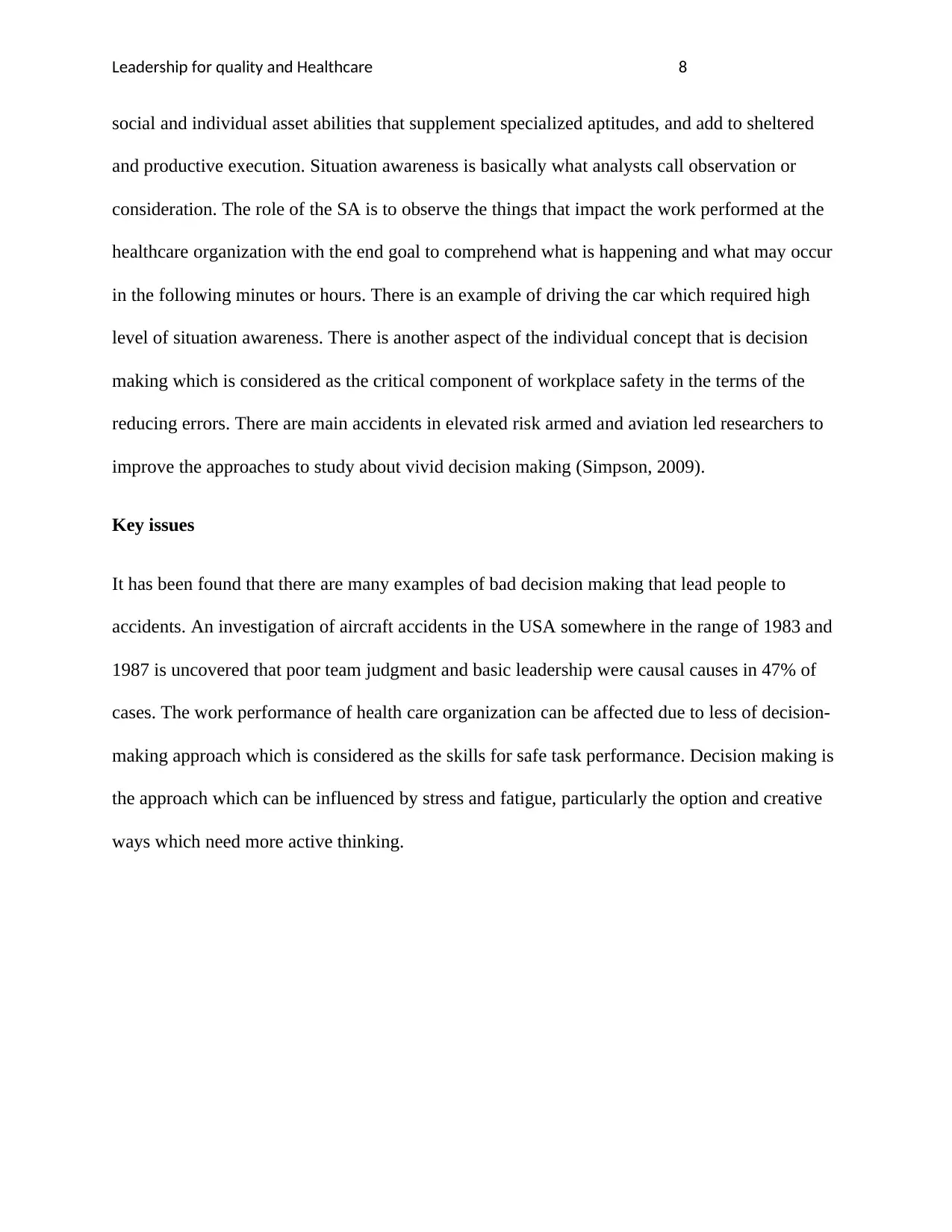
Leadership for quality and Healthcare 8
social and individual asset abilities that supplement specialized aptitudes, and add to sheltered
and productive execution. Situation awareness is basically what analysts call observation or
consideration. The role of the SA is to observe the things that impact the work performed at the
healthcare organization with the end goal to comprehend what is happening and what may occur
in the following minutes or hours. There is an example of driving the car which required high
level of situation awareness. There is another aspect of the individual concept that is decision
making which is considered as the critical component of workplace safety in the terms of the
reducing errors. There are main accidents in elevated risk armed and aviation led researchers to
improve the approaches to study about vivid decision making (Simpson, 2009).
Key issues
It has been found that there are many examples of bad decision making that lead people to
accidents. An investigation of aircraft accidents in the USA somewhere in the range of 1983 and
1987 is uncovered that poor team judgment and basic leadership were causal causes in 47% of
cases. The work performance of health care organization can be affected due to less of decision-
making approach which is considered as the skills for safe task performance. Decision making is
the approach which can be influenced by stress and fatigue, particularly the option and creative
ways which need more active thinking.
social and individual asset abilities that supplement specialized aptitudes, and add to sheltered
and productive execution. Situation awareness is basically what analysts call observation or
consideration. The role of the SA is to observe the things that impact the work performed at the
healthcare organization with the end goal to comprehend what is happening and what may occur
in the following minutes or hours. There is an example of driving the car which required high
level of situation awareness. There is another aspect of the individual concept that is decision
making which is considered as the critical component of workplace safety in the terms of the
reducing errors. There are main accidents in elevated risk armed and aviation led researchers to
improve the approaches to study about vivid decision making (Simpson, 2009).
Key issues
It has been found that there are many examples of bad decision making that lead people to
accidents. An investigation of aircraft accidents in the USA somewhere in the range of 1983 and
1987 is uncovered that poor team judgment and basic leadership were causal causes in 47% of
cases. The work performance of health care organization can be affected due to less of decision-
making approach which is considered as the skills for safe task performance. Decision making is
the approach which can be influenced by stress and fatigue, particularly the option and creative
ways which need more active thinking.
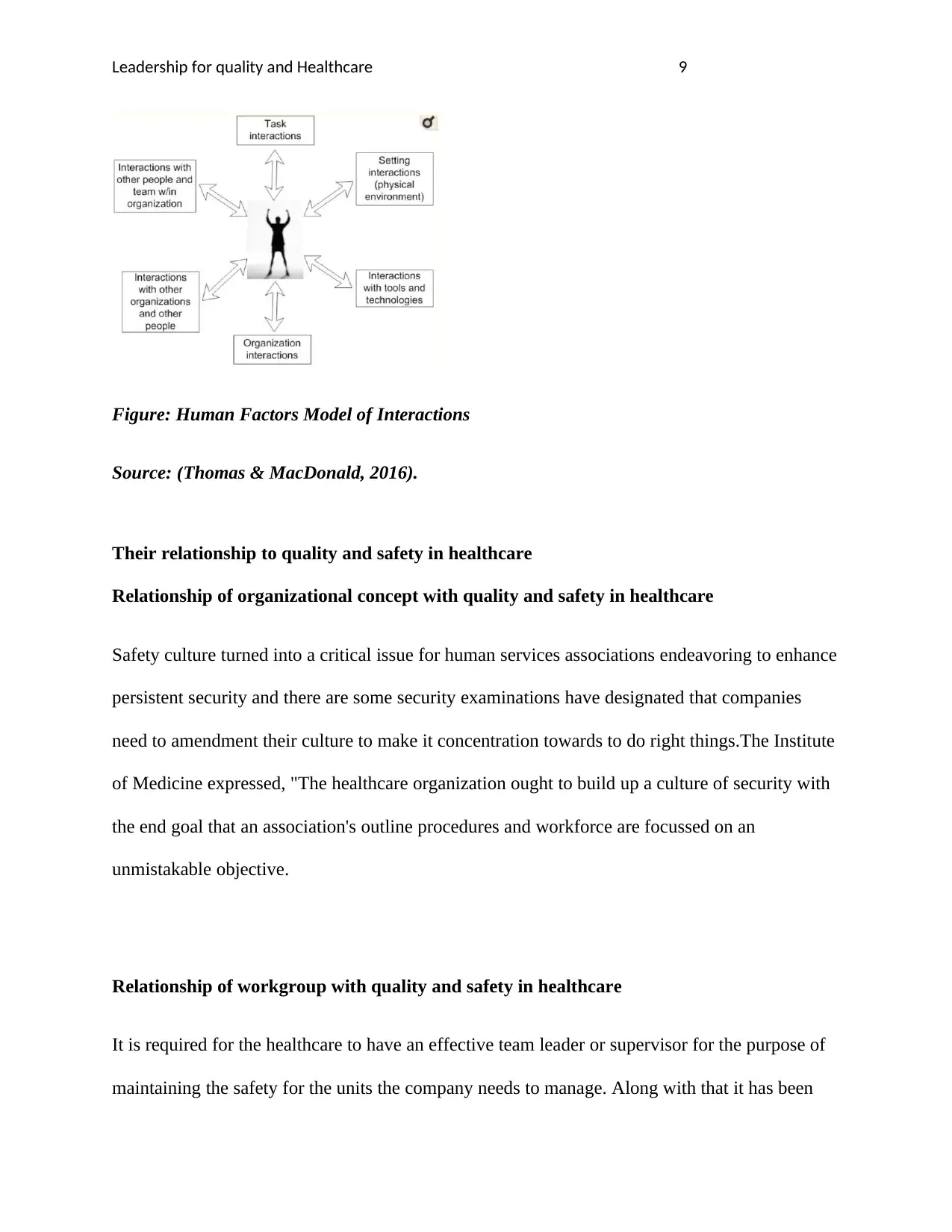
Leadership for quality and Healthcare 9
Figure: Human Factors Model of Interactions
Source: (Thomas & MacDonald, 2016).
Their relationship to quality and safety in healthcare
Relationship of organizational concept with quality and safety in healthcare
Safety culture turned into a critical issue for human services associations endeavoring to enhance
persistent security and there are some security examinations have designated that companies
need to amendment their culture to make it concentration towards to do right things.The Institute
of Medicine expressed, "The healthcare organization ought to build up a culture of security with
the end goal that an association's outline procedures and workforce are focussed on an
unmistakable objective.
Relationship of workgroup with quality and safety in healthcare
It is required for the healthcare to have an effective team leader or supervisor for the purpose of
maintaining the safety for the units the company needs to manage. Along with that it has been
Figure: Human Factors Model of Interactions
Source: (Thomas & MacDonald, 2016).
Their relationship to quality and safety in healthcare
Relationship of organizational concept with quality and safety in healthcare
Safety culture turned into a critical issue for human services associations endeavoring to enhance
persistent security and there are some security examinations have designated that companies
need to amendment their culture to make it concentration towards to do right things.The Institute
of Medicine expressed, "The healthcare organization ought to build up a culture of security with
the end goal that an association's outline procedures and workforce are focussed on an
unmistakable objective.
Relationship of workgroup with quality and safety in healthcare
It is required for the healthcare to have an effective team leader or supervisor for the purpose of
maintaining the safety for the units the company needs to manage. Along with that it has been
⊘ This is a preview!⊘
Do you want full access?
Subscribe today to unlock all pages.

Trusted by 1+ million students worldwide
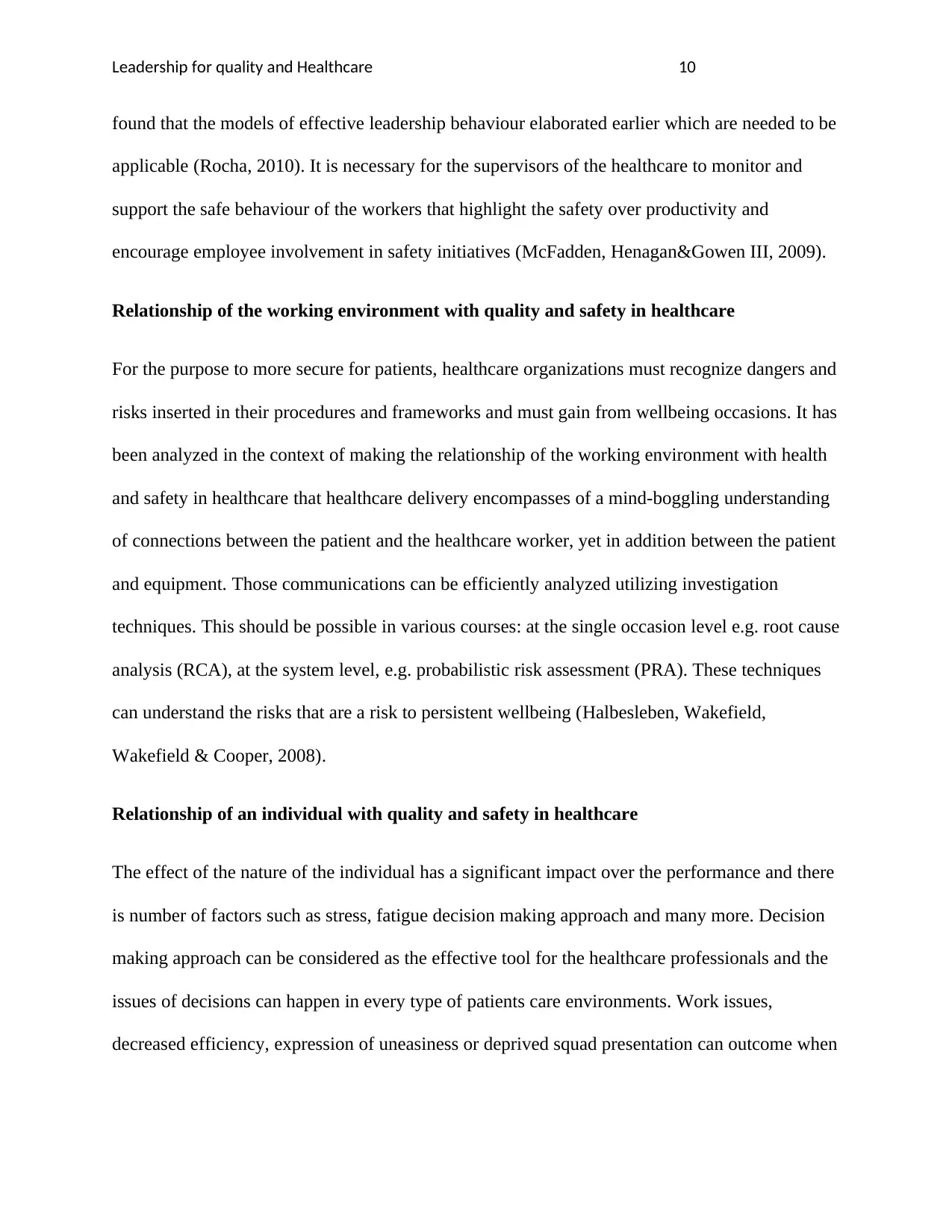
Leadership for quality and Healthcare 10
found that the models of effective leadership behaviour elaborated earlier which are needed to be
applicable (Rocha, 2010). It is necessary for the supervisors of the healthcare to monitor and
support the safe behaviour of the workers that highlight the safety over productivity and
encourage employee involvement in safety initiatives (McFadden, Henagan&Gowen III, 2009).
Relationship of the working environment with quality and safety in healthcare
For the purpose to more secure for patients, healthcare organizations must recognize dangers and
risks inserted in their procedures and frameworks and must gain from wellbeing occasions. It has
been analyzed in the context of making the relationship of the working environment with health
and safety in healthcare that healthcare delivery encompasses of a mind-boggling understanding
of connections between the patient and the healthcare worker, yet in addition between the patient
and equipment. Those communications can be efficiently analyzed utilizing investigation
techniques. This should be possible in various courses: at the single occasion level e.g. root cause
analysis (RCA), at the system level, e.g. probabilistic risk assessment (PRA). These techniques
can understand the risks that are a risk to persistent wellbeing (Halbesleben, Wakefield,
Wakefield & Cooper, 2008).
Relationship of an individual with quality and safety in healthcare
The effect of the nature of the individual has a significant impact over the performance and there
is number of factors such as stress, fatigue decision making approach and many more. Decision
making approach can be considered as the effective tool for the healthcare professionals and the
issues of decisions can happen in every type of patients care environments. Work issues,
decreased efficiency, expression of uneasiness or deprived squad presentation can outcome when
found that the models of effective leadership behaviour elaborated earlier which are needed to be
applicable (Rocha, 2010). It is necessary for the supervisors of the healthcare to monitor and
support the safe behaviour of the workers that highlight the safety over productivity and
encourage employee involvement in safety initiatives (McFadden, Henagan&Gowen III, 2009).
Relationship of the working environment with quality and safety in healthcare
For the purpose to more secure for patients, healthcare organizations must recognize dangers and
risks inserted in their procedures and frameworks and must gain from wellbeing occasions. It has
been analyzed in the context of making the relationship of the working environment with health
and safety in healthcare that healthcare delivery encompasses of a mind-boggling understanding
of connections between the patient and the healthcare worker, yet in addition between the patient
and equipment. Those communications can be efficiently analyzed utilizing investigation
techniques. This should be possible in various courses: at the single occasion level e.g. root cause
analysis (RCA), at the system level, e.g. probabilistic risk assessment (PRA). These techniques
can understand the risks that are a risk to persistent wellbeing (Halbesleben, Wakefield,
Wakefield & Cooper, 2008).
Relationship of an individual with quality and safety in healthcare
The effect of the nature of the individual has a significant impact over the performance and there
is number of factors such as stress, fatigue decision making approach and many more. Decision
making approach can be considered as the effective tool for the healthcare professionals and the
issues of decisions can happen in every type of patients care environments. Work issues,
decreased efficiency, expression of uneasiness or deprived squad presentation can outcome when
Paraphrase This Document
Need a fresh take? Get an instant paraphrase of this document with our AI Paraphraser
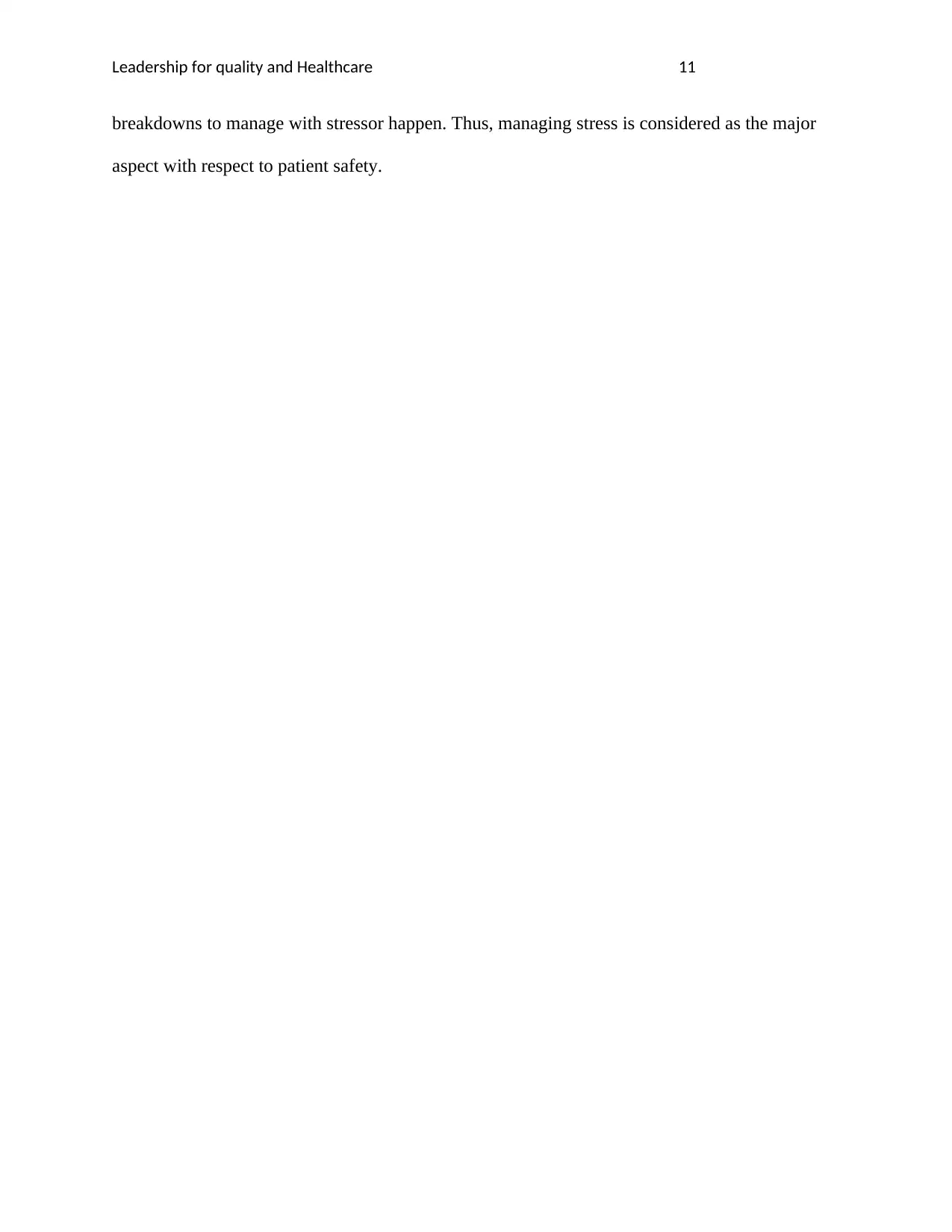
Leadership for quality and Healthcare 11
breakdowns to manage with stressor happen. Thus, managing stress is considered as the major
aspect with respect to patient safety.
breakdowns to manage with stressor happen. Thus, managing stress is considered as the major
aspect with respect to patient safety.
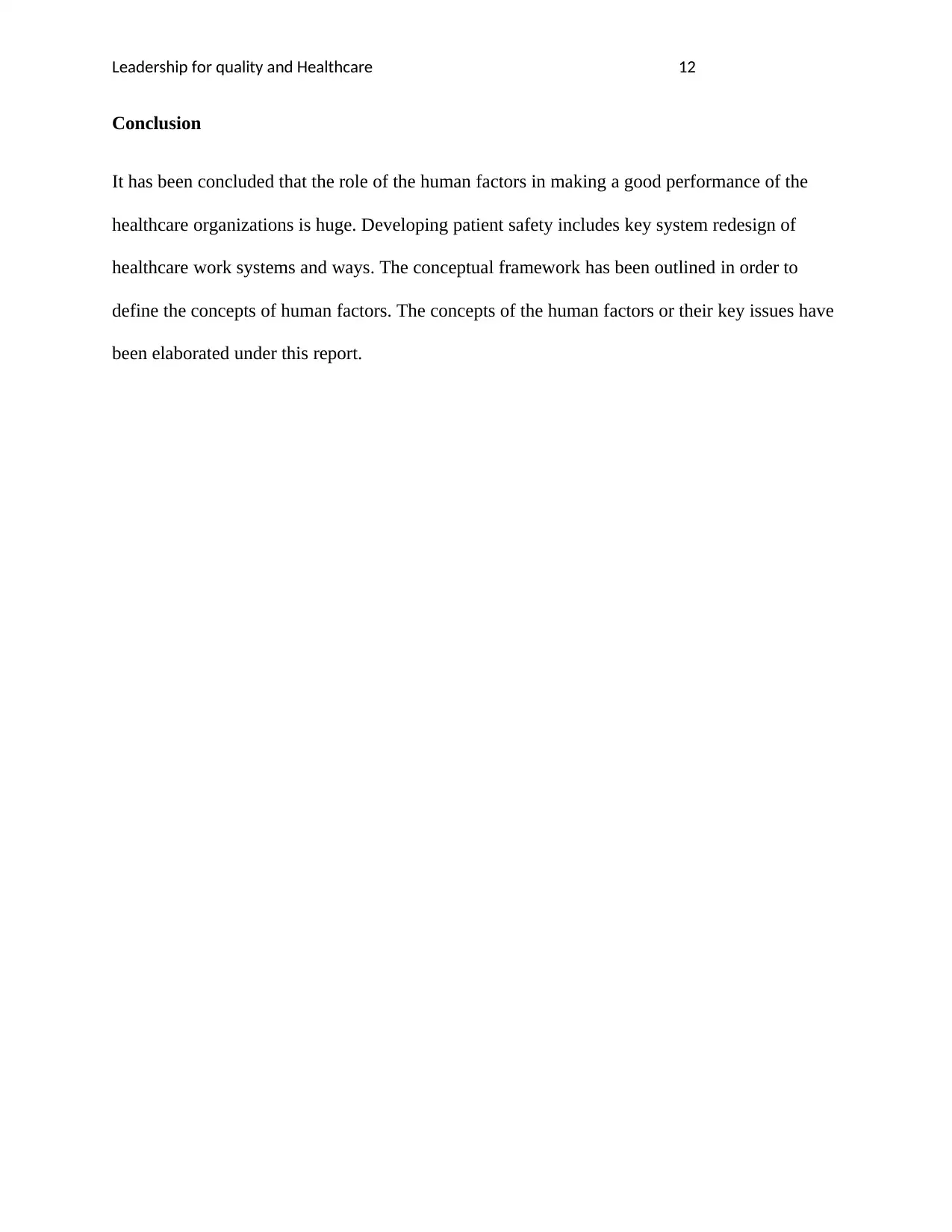
Leadership for quality and Healthcare 12
Conclusion
It has been concluded that the role of the human factors in making a good performance of the
healthcare organizations is huge. Developing patient safety includes key system redesign of
healthcare work systems and ways. The conceptual framework has been outlined in order to
define the concepts of human factors. The concepts of the human factors or their key issues have
been elaborated under this report.
Conclusion
It has been concluded that the role of the human factors in making a good performance of the
healthcare organizations is huge. Developing patient safety includes key system redesign of
healthcare work systems and ways. The conceptual framework has been outlined in order to
define the concepts of human factors. The concepts of the human factors or their key issues have
been elaborated under this report.
⊘ This is a preview!⊘
Do you want full access?
Subscribe today to unlock all pages.

Trusted by 1+ million students worldwide
1 out of 14
Related Documents
Your All-in-One AI-Powered Toolkit for Academic Success.
+13062052269
info@desklib.com
Available 24*7 on WhatsApp / Email
![[object Object]](/_next/static/media/star-bottom.7253800d.svg)
Unlock your academic potential
Copyright © 2020–2025 A2Z Services. All Rights Reserved. Developed and managed by ZUCOL.




